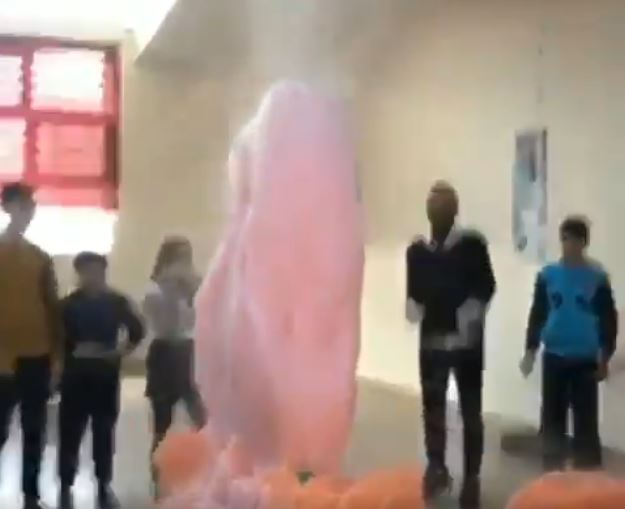An instructor and two children pour three cups of powder into a bin of red liquid.
Suddenly — poof — a cloud of what looks like cotton candy explodes toward the ceiling.

This elephant toothpaste video is a rather dangerous version of a classic chemistry demonstration. The reaction is commonly used in chemistry classrooms to explain catalysts. But here, it turned out-of-control:
Bagaikan mengundang iblis dari neraka tanpa mantra, reaksi ini disebut "The Elephant's Toothpaste".
— Semesta Sains (@semestasains) June 7, 2019
Hidrogen Peroksida dicampur katalis Potasium Iodida akan mengalami dekomposisi yg sangat cepat.
Kakak2 Kimia mudah2an mau bantu menjelaskan lebih detail. pic.twitter.com/AN6kjvzyNc
Easy but very explosive
The reaction uses cheap, easy-to-access ingredients: hydrogen peroxide, dish soap, potassium iodide and food coloring.
Hydrogen peroxide is key. It’s made up of two hydrogen and two oxygen molecules. The bonds between these molecules naturally break, so over time, hydrogen peroxide slowly becomes water and oxygen gas.
Normally, the slow breakup of hydrogen peroxide into water and oxygen is unnoticeable. But the elephant’s toothpaste experiment speeds the process with a catalyst, a chemical compound that increases the rate of a given reaction. Potassium iodide provides that catalyst.
In the presence of potassium iodide, hydrogen peroxide decomposes almost immediately.
So what’s going on?
The setup is simple. Hydrogen peroxide is mixed with dish soap, and food coloring is often added for a dramatic effect – the cotton-candy pink in the Twitter video.
The potassium iodide is added, and the iodide ion that’s part of that compound attracts the oxygen in the hydrogen peroxide, breaking the bonds and rapidly transforming the hydrogen peroxide into water and oxygen gas.
The oxygen molecules then get trapped by the soap, forming bubbles. But I wouldn’t recommend trying it at home!
Why did the bubbles fly toward the ceiling?
Usually, the elephant’s toothpaste experiment creates an oozy concoction. In the Twitter video, the particular reaction was due to the strength of the ingredients and the shape of the containers.
I wouldn’t try this experiment at home as hydrogen peroxide can cause very bad chemical burns. Moreover, the reaction if not done properly could heat the solution by hundreds of degrees.
[Twitter]











